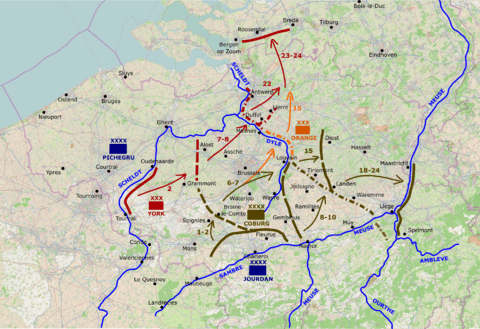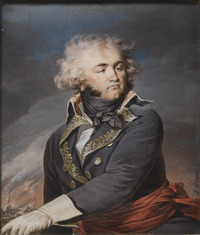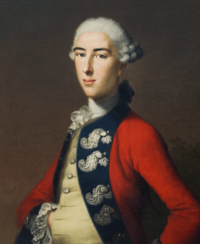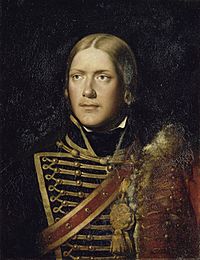Siege of Maastricht (1794) facts for kids
Quick facts for kids Siege of Maastricht (1794) |
|||||||
|---|---|---|---|---|---|---|---|
| Part of the Flanders campaign in the War of the First Coalition | |||||||
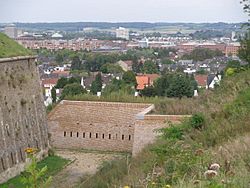 Fort St. Pieter is part of the old defenses of Maastricht. |
|||||||
|
|||||||
| Belligerents | |||||||
| Commanders and leaders | |||||||
| Units involved | |||||||
| Army of Sambre-et-Meuse | Coalition | ||||||
| Strength | |||||||
| 35,608 | 8,000, 344 guns | ||||||
| Casualties and losses | |||||||
| 300 | 500, 344 guns Garrison went free. |
||||||
The Siege of Maastricht (September 22 – November 4, 1794) was a successful attack on the city of Maastricht. French forces, led by General Jean-Baptiste Kléber, surrounded and attacked the city. The defenders were a mix of Austrian and Dutch soldiers. They were commanded by Prince Frederick of Hesse-Kassel. This event was part of the larger War of the First Coalition. In the end, the French won, and the city surrendered.
Contents
Why the Siege Happened
After the Battle of Fleurus
The Battle of Fleurus on June 26, 1794, was a very important fight. It was a turning point in the war. The French army, led by General Jean-Baptiste Jourdan, won a big victory. This made the armies fighting against France, called the Coalition, start to retreat.
The Coalition armies included soldiers from Austria, Britain, and the Dutch Republic. After their loss at Fleurus, they began to pull back. The British and Dutch armies went north. The Austrian army moved east.
French Armies Advance
As the Coalition retreated, the French armies pushed forward. General Jourdan's army kept winning battles against the Austrians. This forced the Austrian army to move back across the Rhine River.
With the Austrians gone, Maastricht was left alone. It had a Coalition army inside its walls. General Jourdan then sent General Kléber and his army to capture Maastricht. This was a key city to control.
Taking Control of Belgium
The French army continued to advance into what is now Belgium. They captured many cities. On July 1, Jourdan took Mons. This made the British troops retreat further.
By July 10, the French had taken Brussels, a major city. The Coalition armies kept moving back. The British and Hanoverian troops went north into the Dutch Republic. The Austrian army moved behind the Meuse River.
The French also started to take back fortresses they had lost earlier. Many of these strongholds surrendered. This allowed more French soldiers to join the main armies. By mid-September, the French were ready to attack again.
On September 18, the French won another battle at Sprimont. This forced the Austrian army to retreat even more. They moved behind the Rur River.
The Siege of Maastricht Begins
Surrounding the City
After the battle at Sprimont, the Austrian army was pushed back. General Kléber's French forces then surrounded Maastricht. The French government wanted the city captured quickly.
General Jourdan sent 15,000 men under General Guillaume Philibert Duhesme to block the city. This meant no one could get in or out. The rest of Kléber's army prepared for the main attack.
The siege of Maastricht officially started on September 22, 1794. The city's defenders had about 8,000 soldiers. They were commanded by Prince Frederick of Hesse-Kassel. The Austrian commander inside the fortress was Wilhelm von Klebeck.
Key Commanders and Events
A young officer named Michel Ney was part of Kléber's staff. He was very brave and was promoted during this time. Kléber's army included several divisions, led by generals like Jean-Baptiste Jules Bernadotte and Louis Friant.
On October 2, the main French army fought the Austrians at the Battle of Aldenhoven. The French won, and the Austrian army had to retreat across the Rhine River. This left Maastricht completely isolated.
With the main Austrian army gone, General Jourdan sent Kléber's full army back to Maastricht. They were now ready to launch a full-scale attack.
The Final Attack
General Kléber asked Prince Frederick to surrender the city. But Prince Frederick refused. So, on November 1, the French began firing their 80 siege guns. The cannons fired non-stop at the city.
The constant bombing broke the spirits of the defenders. Austrian soldiers inside the city started to loot homes. Dutch soldiers even fired on them to stop the chaos.
General Kléber sent Michel Ney into the fortress twice to talk. On his second visit, Ney convinced Prince Frederick to give up. Ney argued that continuing to fight would only destroy the city. Prince Frederick finally agreed to surrender on November 4.
The defenders were allowed to leave the city with their weapons and flags on November 7. They were not taken as prisoners of war. The French captured 344 cannons and 31 regimental flags. The French lost about 300 soldiers. The Coalition lost 500 soldiers killed or wounded.
Maastricht was also home to a famous mosasaur fossil. French scientists asked that the building holding the fossil not be bombed. When the city was captured, the French took the mosasaur's head and sent it to Paris.
Armies Involved
Coalition Forces in Maastricht
The defenders of Maastricht were a mix of soldiers from different nations.
French Siege Army
General Kléber's army was much larger and well-equipped for the siege.
| Divisions | Brigades | Units | Size/Strength |
|---|---|---|---|
| GD Jean-Baptiste Jules Bernadotte 9,215 men |
GB Henri Jacques Jean Boyer | 32nd Light Infantry Demi-Brigade | 1 battalion |
| 21st Line Infantry Demi-Brigade | 3rd Battalion | ||
| 71st Line Infantry Demi-Brigade | 3 battalions | ||
| 72nd Line Infantry Demi-Brigade | 3 battalions | ||
| 2nd Hussar Regiment | - | ||
| 4th Hussar Regiment | - | ||
| 7th Dragoon Regiment | - | ||
| 13th Cavalry Regiment | - | ||
| 32nd Gendarmes | 2 companies | ||
| 34th Gendarmes | 2 companies | ||
| Foot Artillery | 2 batteries | ||
| Engineers | 1 company | ||
| GB Joseph Léonard Richard 9,961 men |
GB André Poncet GB Joseph-Valérian de Boisset |
1st Foot Chasseurs Demi-Brigade | 3 battalions |
| 35th Line Infantry Demi-Brigade | 3 battalions | ||
| 97th Line Infantry Demi-Brigade | 3 battalions | ||
| 127th Line Infantry Demi-Brigade | 3 battalions | ||
| 128th Line Infantry Demi-Brigade | 3 battalions | ||
| 12th Horse Chasseur Regiment | - | ||
| 16th Horse Chasseur Regiment | - | ||
| Foot Artillery | 1 battery | ||
| GD Guillaume Philibert Duhesme 7,663 men |
GB Charles Daurier | 93rd Line Infantry Demi-Brigade | 3 battalions |
| 111th Line Infantry Demi-Brigade | 3 battalions | ||
| 123rd Line Infantry Demi-Brigade | 3 battalions | ||
| Volunteer Chasseurs | 4th Battalion | ||
| 2nd Horse Chasseurs Regiment | - | ||
| 17th Cavalry Regiment | - | ||
| Engineers | 1 company | ||
| GB Louis Friant 8,769 men |
GB Brusette (?) GB Claude Ursule Gency |
33rd Line Infantry Demi-Brigade | 3 battalions |
| 49th Line Infantry Demi-Brigade | 3 battalions | ||
| 74th Line Infantry Demi-Brigade | 2nd Battalion | ||
| 161st Line Infantry Demi-Brigade | 3 battalions | ||
| Guard National Somme | 2nd Battalion | ||
| Guard National Vosges | 3rd Battalion | ||
| Engineers | 1 company | ||
| French totals | - | - | 35,608 men |


